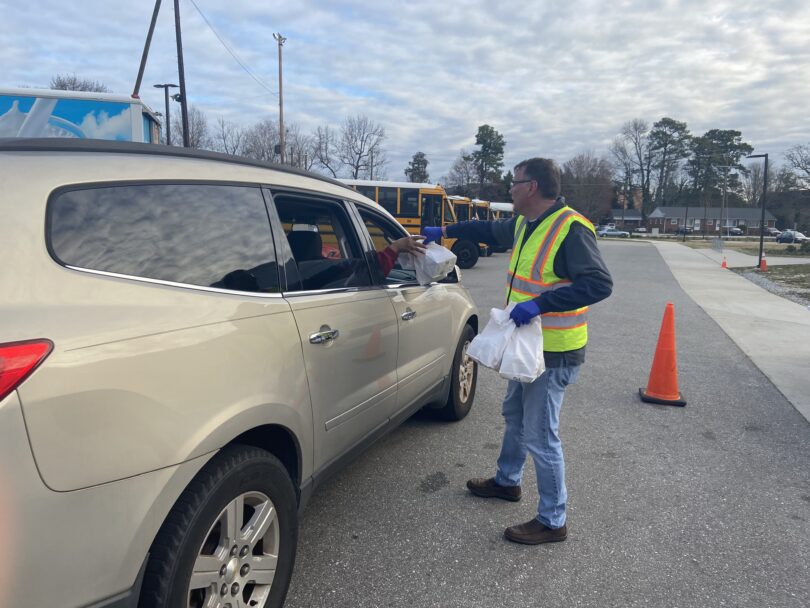During the school year, schools give out about 29.8 million free and low-cost lunches every day across the country through the National School Lunch Program, a federally assisted meal program.
So when the coronavirus pandemic struck and schools closed, feeding kids got a lot more complicated. Schools cannot email students their lunch, nor can they use the cafeteria ovens to make the food, the refrigerators to keep perishables or the trays to put it all together and hand to kids.
But that hasn’t stopped communities across the United States from making sure youth have had access to quality meals. Schools quickly put together plans to set up sites where parents could “grab-and-go” meals, sometimes a few days’ worth at a time. Other school districts ran delivery routes, with school buses ferrying meals instead of kids.
Meanwhile, like in places like Williamsburg, Va., organizations such as Meals on Wheels teamed up with restaurants to prepare and distribute lunches to homeless children in hotels. Other restaurants and food trucks began serving up lunches to schoolkids on their own.
Every Thursday since schools closed, for example, Matchsticks BBQ Co., a food truck in Williamsburg, has been serving lunches to school-aged kids.
“We’ve always been trying to figure out how to help kids in the community who might not be as fortunate as others,” says Matt Sileno, who owns Matchsticks with his wife, Nicole.
Keeping Kids Fed
In Norfolk, Va., the school system, faced with closing down 51 school cafeterias, quickly set up 12 emergency feeding programs at sites across the city, according to Lisa Winter with the Norfolk Public Schools’ Department of School Nutrition.
Since March, distribution has expanded to include five more sites and a school bus that services three other community locations.
What is all means is that despite the quarantine, Norfolk Schools’ has continued to provide seven days’ worth of meals every week which meet United States Department of Agriculture (USDA) guidelines, including hot and cold items, fresh fruits and vegetables, fat free and/or low-fat milk, all with allergy information in each bag.
What makes NPS unique is that the district has a central warehouse and kitchen to store and prepare meals, then distribute them to the 20 total sites across the city. Not only that, but School Nutrition partnered with the Foodbank of Southeastern Virginia, Mercy Chefs, the Chrysler Museum of Art and Norfolk Public Libraries to provide frozen and non-perishable foods, plastic eggs for Easter and educational materials.
These sites aren’t just for students enrolled in Norfolk Schools. Meals — made by hand —are available to any child under the age of 18.
“We have been able to offer assistance to our students and maintain the safety of our staff,” Winter says. “Our staff is really dedicated — even though many of them are in a high-risk health category themselves.”
Shifting Gears for Summer
Now that (virtual) school is over and summer is here, schools are still trying to make sure kids get fed. According to Feeding America, when school is out during the summer, only 1 in 6 kids still have access to meals through the USDA Summer Food Service Program.
In the summer, Norfolk provides meals to over 60 sites across the city. Right now, all of these things aren’t happening.
“If the city of Norfolk opens libraries and recreation center camps we are going to be ready and happy to pivot again and provide meals to them as we normally would,” Winter says.
For now, Norfolk will continue to provide grab-and-go meals at their 20 sites. One new shift is the amount of meals provided to daycare centers and homes, Winter says.
“We want to feed our kids and we miss them,” Winter says. “Our mission is so important and serving the community in this way, in these challenging times, has been a truly rich experience.”
Communities usually offer a variety of summer feeding programs, such as the Backpack Program and School Pantry Program run by local food banks and supported by donors. Some summer meal programs are funded by the federal government through the USDA. Food banks purchase and deliver these meals to existing youth programs within a community.
To Find a Summer Meal Program
- Text: You can find meal programs near you by texting the word FOOD to 877-877, thanks to No Kid Hungry. You’ll get a message with nearby locations. Data and message rates may apply.
- Call: Call the USDA Hotline at 1-866-348-6479 to find free summer food service programs in your area.
- Ask Your Local Food Bank: Search by zip code or state using the food bank locator at www.feedingamerica.org/find-your-local-foodbank and contact the food bank nearest you. Even if the food bank looks far away, they often work with meal programs closer to your home.

